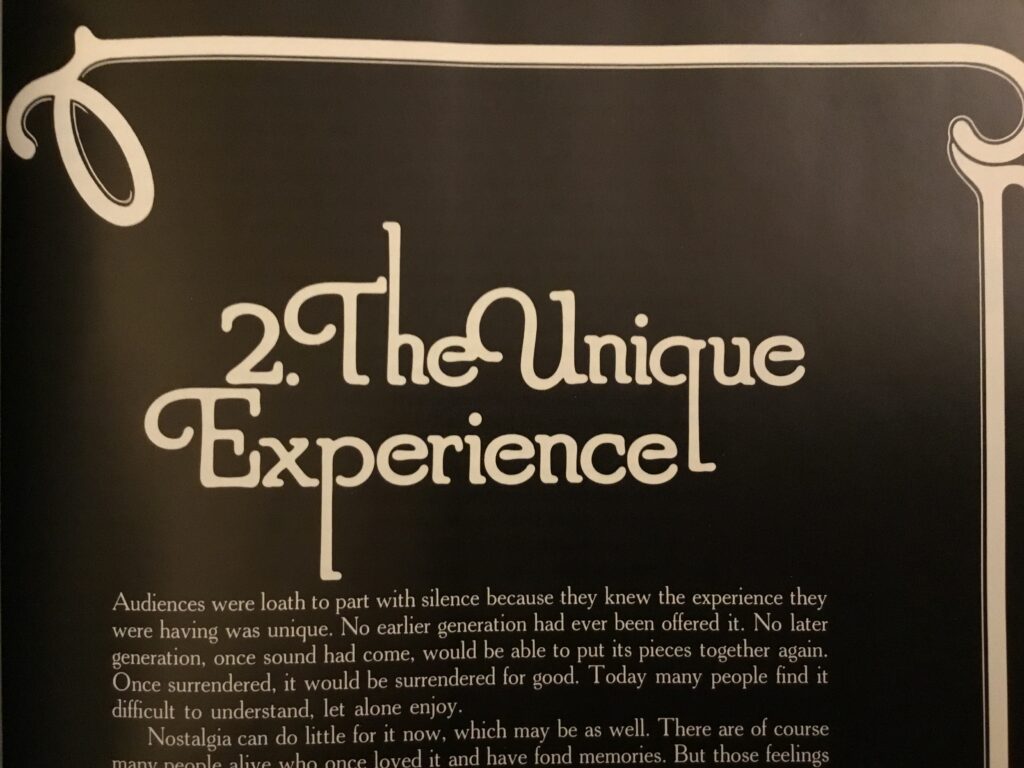A friend of mine once enlikened watching a silent film, especially in a theater, to being in a sort of trance state. An apt distillation of what Walter Kerr discusses in chapter two of The Silent Clowns’ Part One, “The Unique Experience”. The experience he writes of is a mix of one that only exists for those who had it themselves during the silent era and what may allow us to get something close to it today.
There is certainly something magical about seeing a silent film, or any classic film, in a vintage movie theater or palace. The light reflected off the screen gently illuminates the proscenium and dribbles over to the walls and ceiling. I find that this reminds me, out of the corner of my mind, that I’m sitting in the same space that people were when this film was originally shown in that cinema. That I’m experiencing the movie-intake experience of those decades-ago audience members, on top of the journey I am on with the film itself.
Kerr describes his own childhood movie-going and sensory memories, evoking the smells of “leather and nitrate and buttered popcorn” and the sound of the theatre organ. While some of these elements are tied to one’s own memories and life, some of them either still exist or can be recreated in a contemporary classic movie-going experience. The “smoke curls” of nostalgia of what it must have been to people in the 1920s are impossible to create.
What remains, and carries over from that time, is the combination of fact and fantasy of Silent Film, which Kerr delineates in chapters three and four. As an example he cites a sequence from the Lloyd Hamilton comedy Move Along. Every gag in the sequence cited is one that takes place in reality, captured by the camera, but the logic and consequence of the actions and the gags are born more of fantasy.
They are gags which could be done in a circus, vaudeville or stage act and be accepted because in our viewing and experiencing a live performance our imagination is activated from the moment the curtain goes up. We’re not really in France or Boston and the people we see aren’t from the 18th or 19th centuries, and we make the adjustment and go along.
We wouldn’t buy these gags or bits of business in a film with color and conch-sound and real-time speed, because our expectation of reality is too great. We’d take what we’re seeing as being more literal or linear. But Silent Film is more of a hybrid of these two realities, the fusing of seeing something as it actually is and of taking in something that we are simultaneously suspending a hunk of our expectation of reality.
This dispensation of logic and consequence, as well as in some cases laws of gravity and physics, is what is unique and special about Silent Film. It’s more than dressing in 1920s clothing and performing in gesture and pantomime.
(Rest assured…I’m not going to describe and discuss every chapter in The Silent Clowns in this series of posts. I’ve set out here to write posts about my own findings, impressions and experiences with understanding the language of Silent Film here. The opening chapters of Walter Kerr’s book, as it turns out, form the foundation of most of this, and so this is what I’m leading off with in the first week of these blog posts.)
The first post in this series is here.
The previous post to this one is here.
The next post is here.
Copies of The Silent Clowns turn up on eBay.
Here is the sequence from Move Along Walter Kerr describes in this chapter, uploaded to YouTube by someone most probably who lifted it from the Looser Than Loose DVD set of Lloyd Hamilton films.
